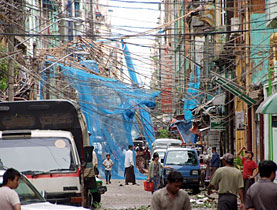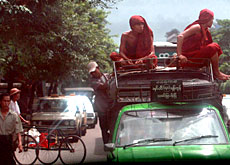Swiss send aid for “monumental catastrophe”

Switzerland has sent an initial SFr700,000 ($670,000) to Myanmar, where a powerful cyclone has killed at least 22,000 people and left hundreds of thousands homeless.
The Swiss Agency for Development and Cooperation (SDC) has contributed SFr500,000 and the Swiss Red Cross SFr200,000.
The Swiss aid, which will focus on providing care, drinking water and shelter, is part of international efforts to bring relief to victims of Cyclone Nargis, which tore through the country’s rice bowl and biggest city of Yangon early on Saturday.
Four aid officials will travel to the disaster area as soon as the military authorities grant entrance visas, said Toni Frisch, head of the Swiss Humanitarian Aid Unit at the SDC.
Three additional staff are being dispatched to Thailand to work alongside United Nations organisations and non-governmental groups.
“Logistically it’s proving to be an extraordinarily challenging operation,” said Matt Cochrane of the Geneva-based International Federation of Red Cross and Red Crescent Societies.
“The storm has had a severe impact on what was already a fairly basic infrastructure, so roads either have been washed away or are impassable,” he told swissinfo. “Communication and electricity lines are down.”
Red Cross relief workers were on the ground soon after the storm hit, assessing the situation in the district of Yangon and distributing insecticide-treated bed nets to help prevent malaria and water purification tablets.
“I think there’s an understandable tendency for frustration, but we’re still in the very early days of responding to what is a monumental catastrophe, so we’re optimistic that access will improve and that assistance will really pick up pace and get to the people affected,” Cochrane said.
Based on a satellite map made available by the United Nations, the storm’s damage was concentrated over a 30,000-square-kilometre area along the Andaman Sea and Gulf of Martaban coastlines – less than five per cent of the country. But the affected region is home to nearly a quarter of Myanmar’s 57 million people.
Tidal wave
On Tuesday Myanmar’s military government raised its death toll to just under 22,500, state media reported. An additional 41,000 people were missing as a result of the cyclone, which ploughed into the Irrawaddy delta, triggering a massive storm surge that swept inland.
“More deaths were caused by the tidal wave than the storm itself,” Minister for Relief and Resettlement Maung Maung Swe told a news conference in Yangon, where food and water supplies are running low.
“The wave was up to 3.5 metres high and it swept away and inundated half the houses in low-lying villages,” he said, giving the first detailed description of the weekend cyclone. “They did not have anywhere to flee.”
It is the worst cyclone to hit Asia since 1991, when 143,000 people died in Bangladesh.
The disaster drew a rare acceptance of outside help from the diplomatically isolated generals, who spurned such approaches in the aftermath of the 2004 Indian Ocean tsunami.
Reflecting the scale of the disaster, the ruling junta said it would postpone to May 24 a constitutional referendum in the worst hit areas of Yangon and the sprawling Irrawaddy delta.
swissinfo, Thomas Stephens
Governments and relief agencies around the world have promised more than $10 million worth of aid and technical support to Myanmar.
A five-member UN Disaster Assessment and Coordination team has assembled in Bangkok. UNICEF has sent assessment teams to three of the five disaster-hit areas.
The Myanmar government said it would allocate five billion kyats ($4.5 million) for relief and resettlement work.
Myanmar, formerly Burma, has been under military rule since 1962.
A massive hike in fuel prices last September sparked almost two weeks of sustained popular protest, which were halted when police and soldiers opened fire on demonstrators.
The UN says the junta is also holding more than 1,100 political prisoners.
Nobel peace laureate and opposition leader Aung San Suu Kyi has been under house arrest for 11 of the past 17 years.
ICRC staff have not visited her since September 2003.

In compliance with the JTI standards
More: SWI swissinfo.ch certified by the Journalism Trust Initiative














You can find an overview of ongoing debates with our journalists here . Please join us!
If you want to start a conversation about a topic raised in this article or want to report factual errors, email us at english@swissinfo.ch.